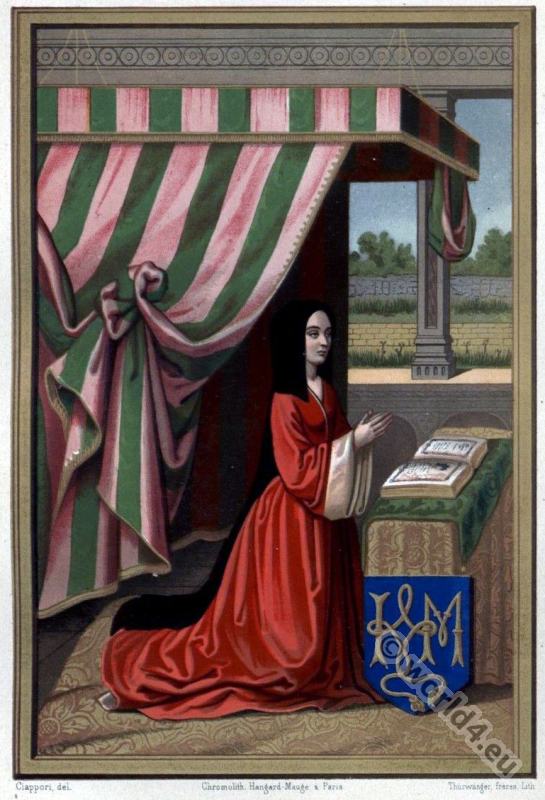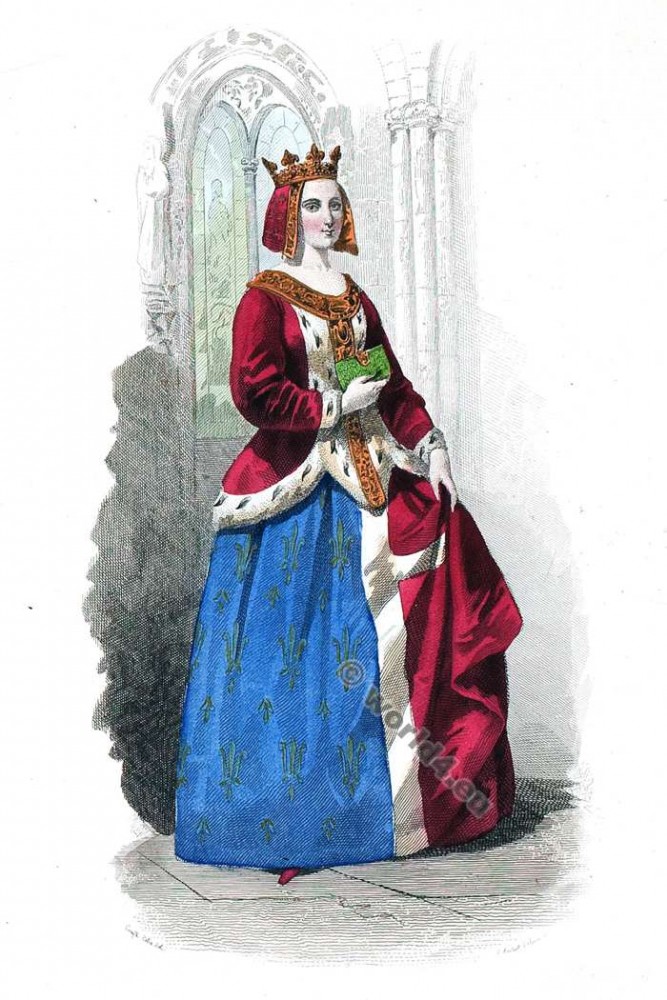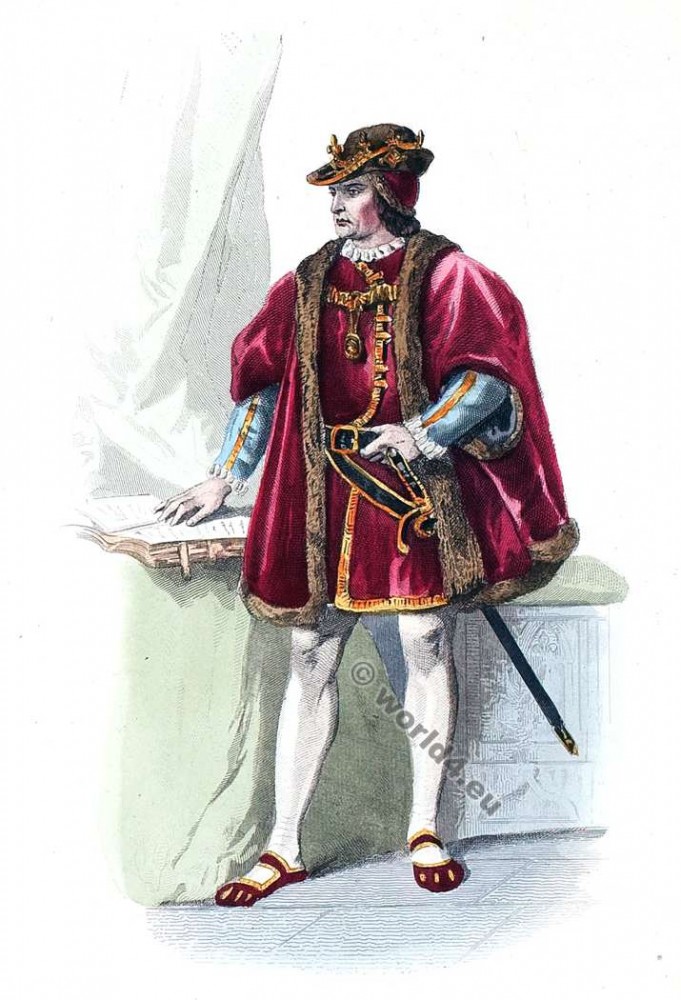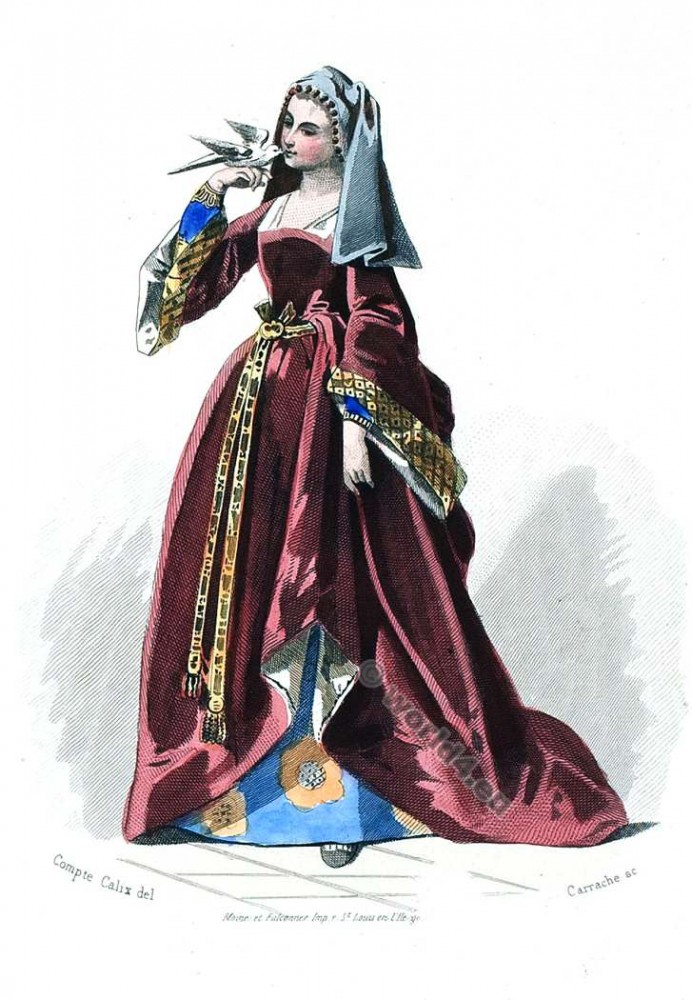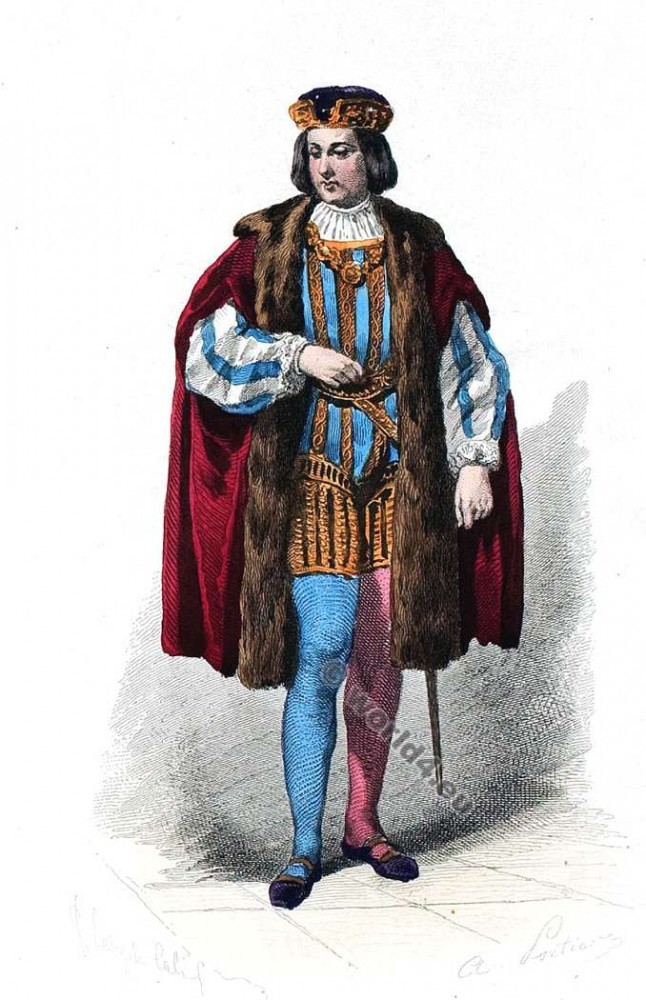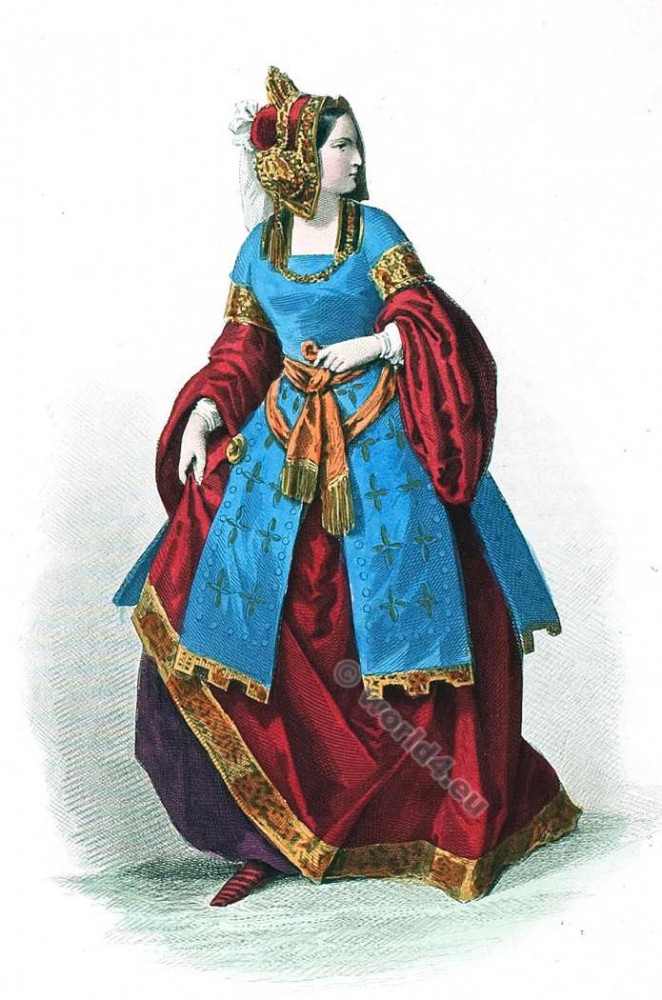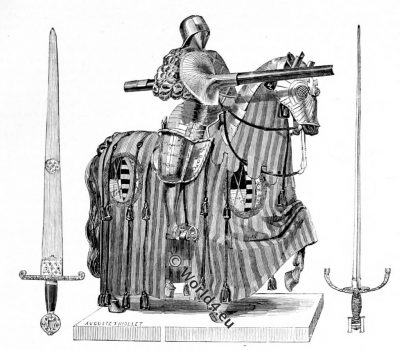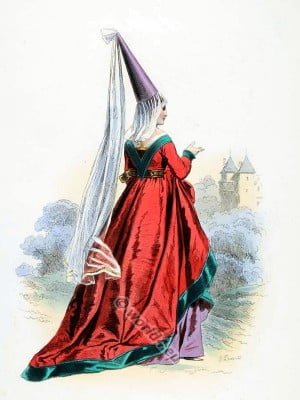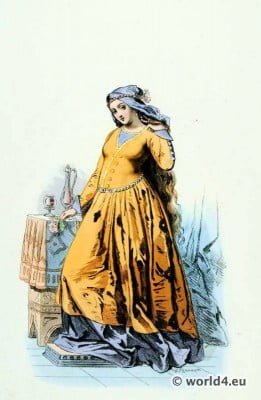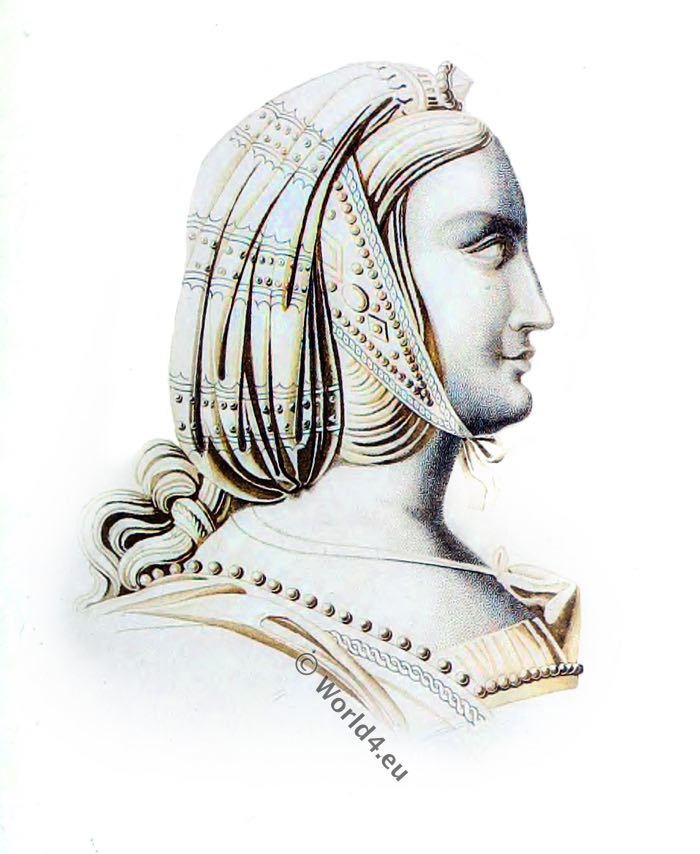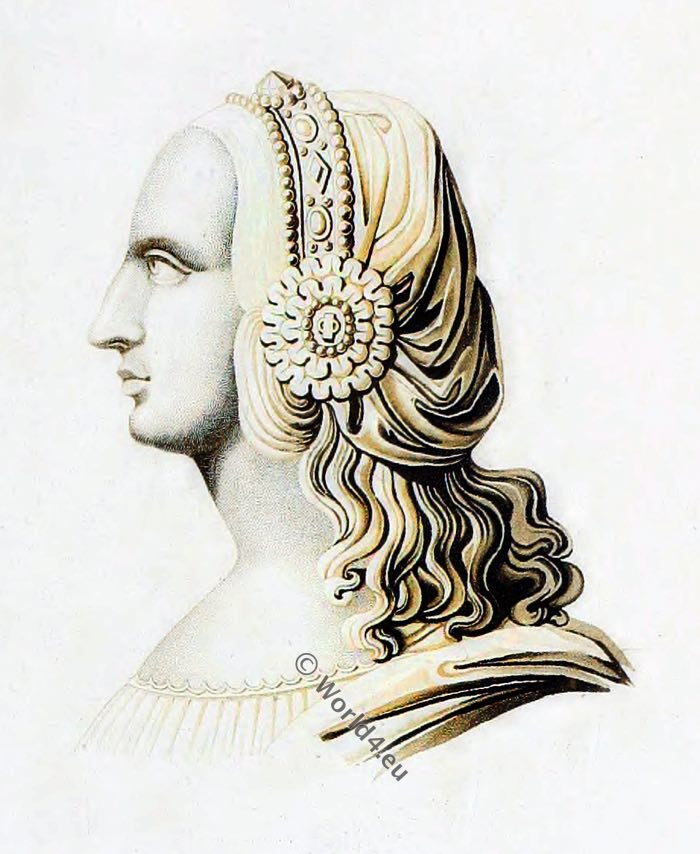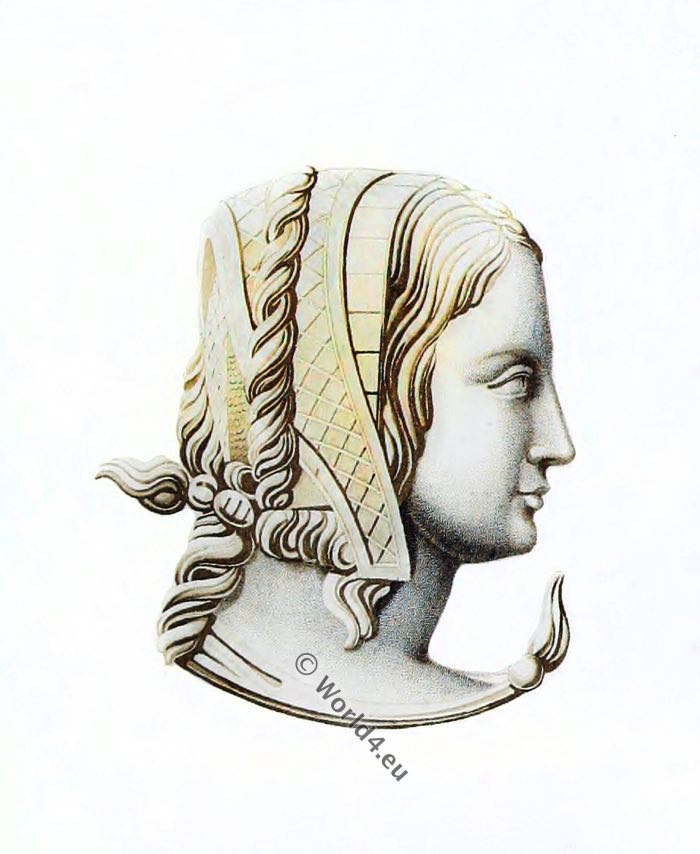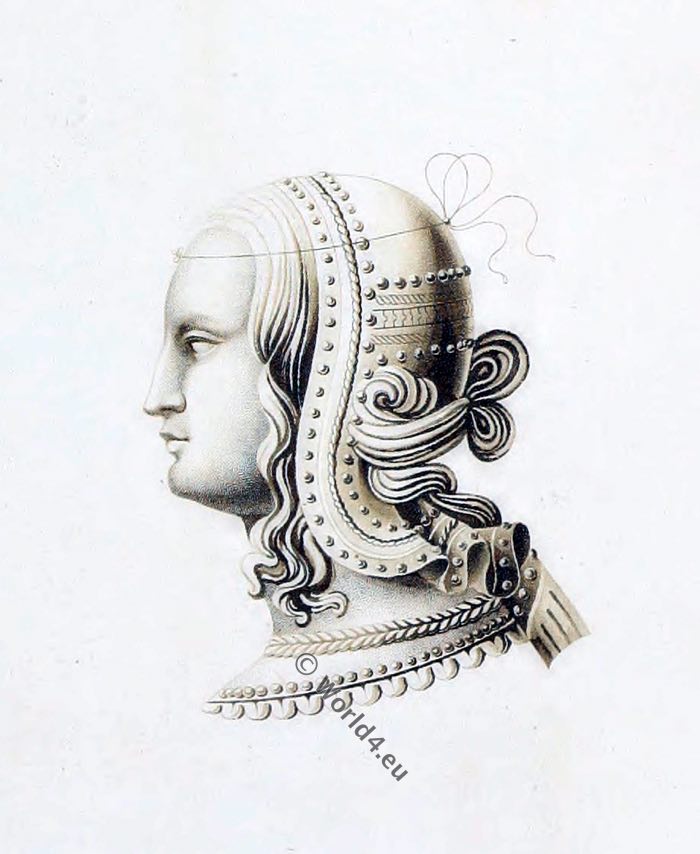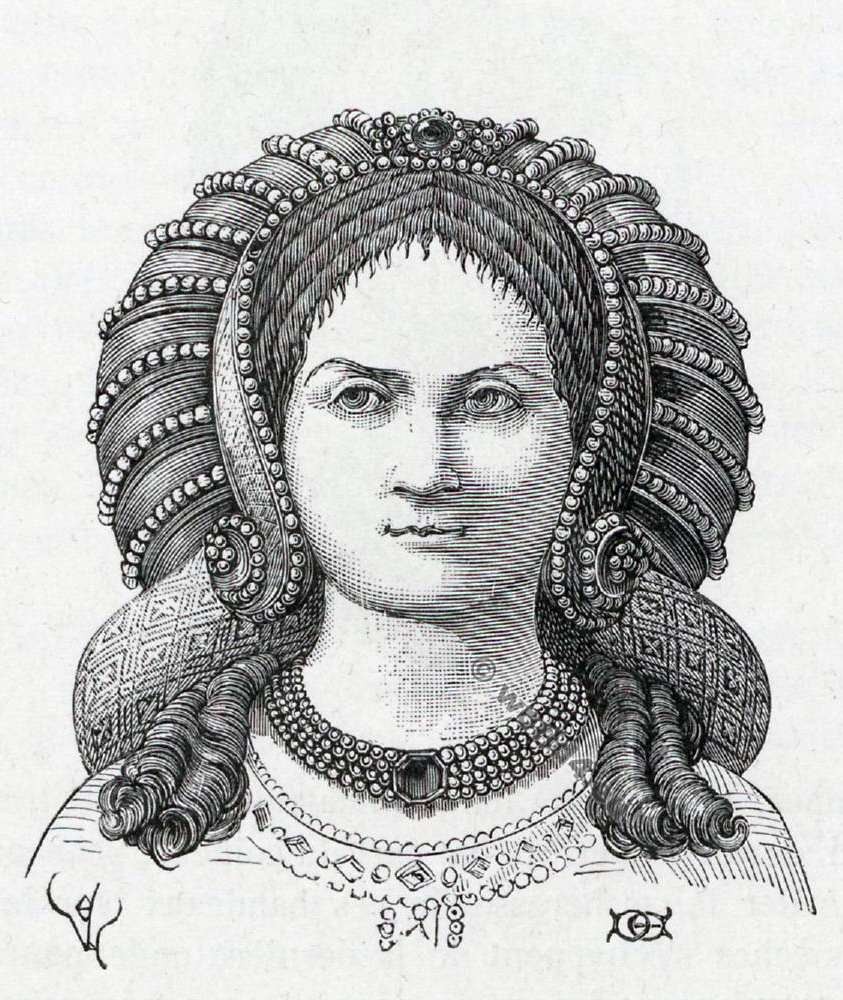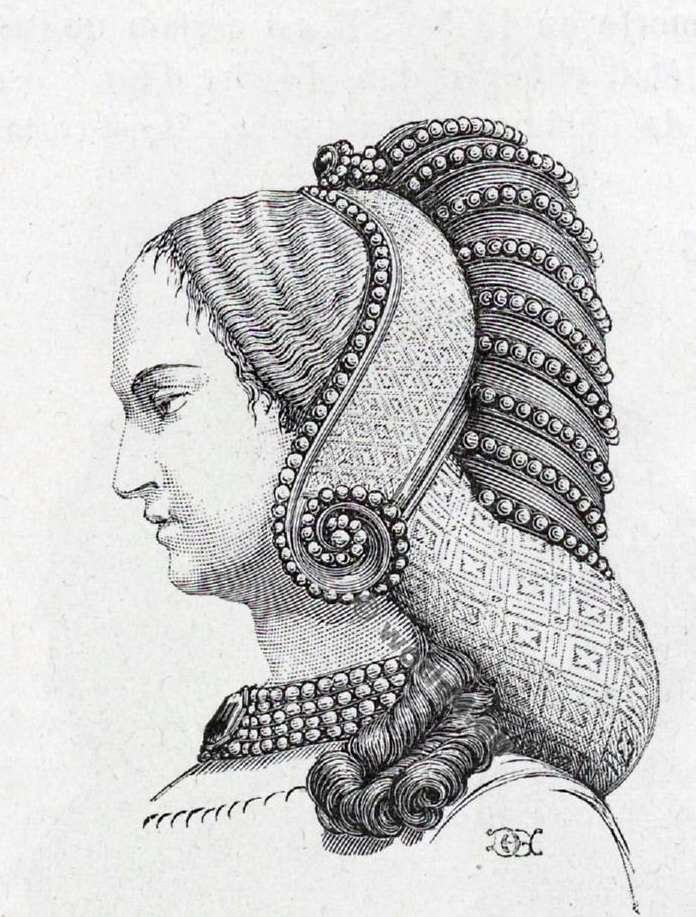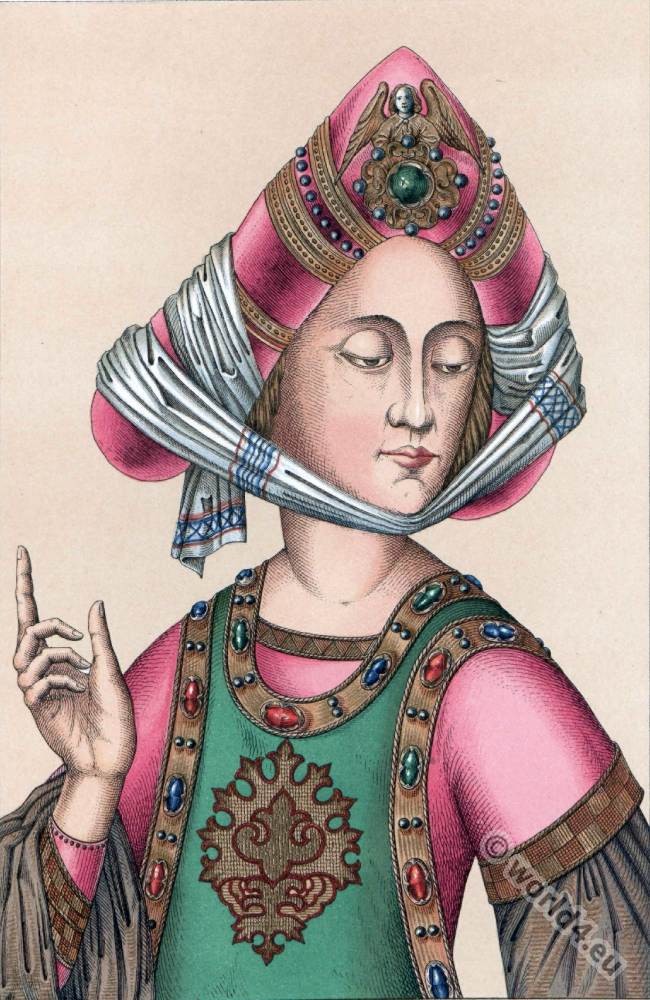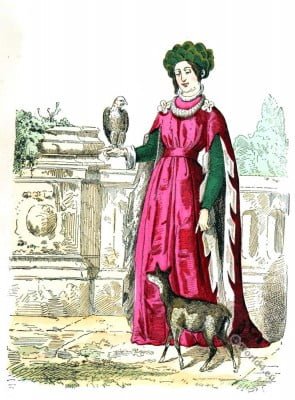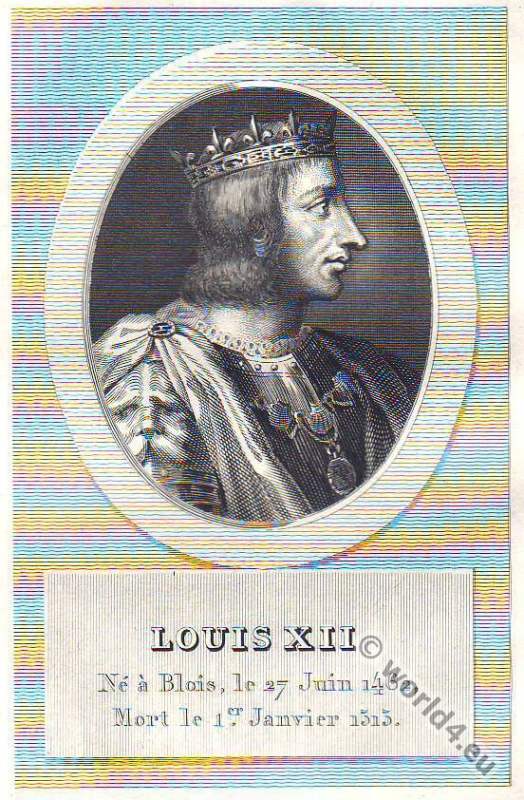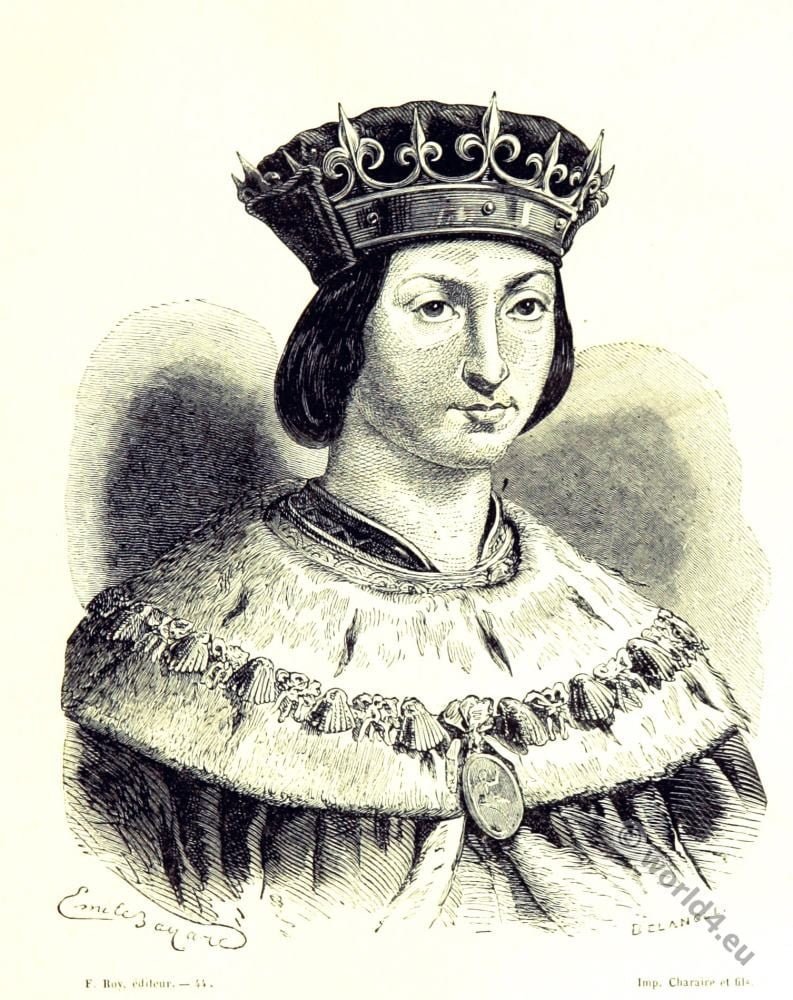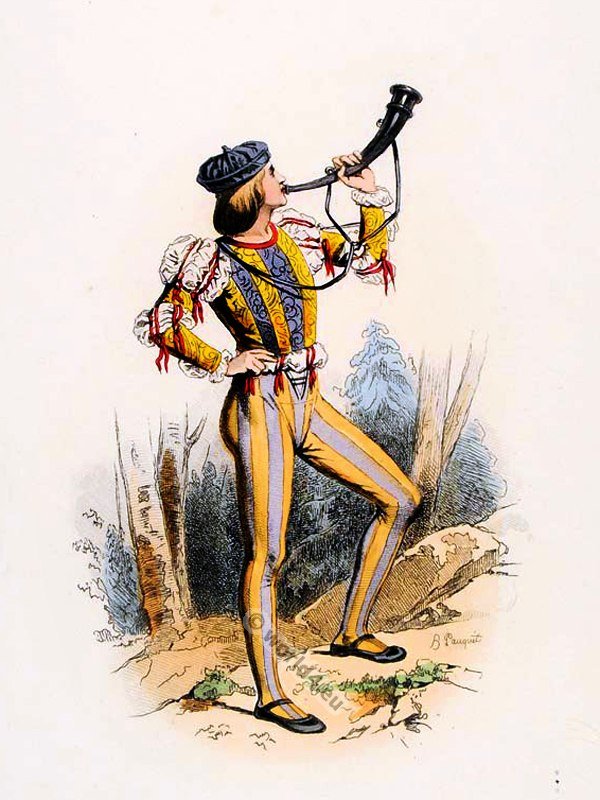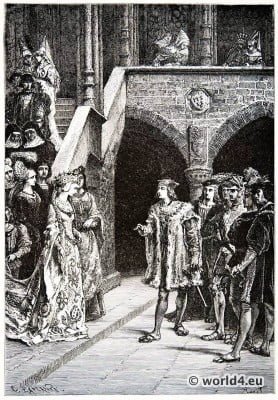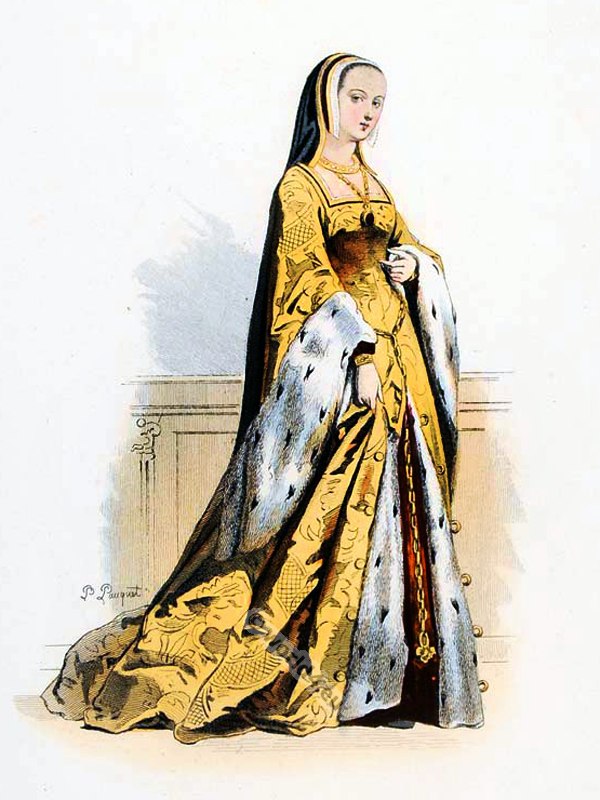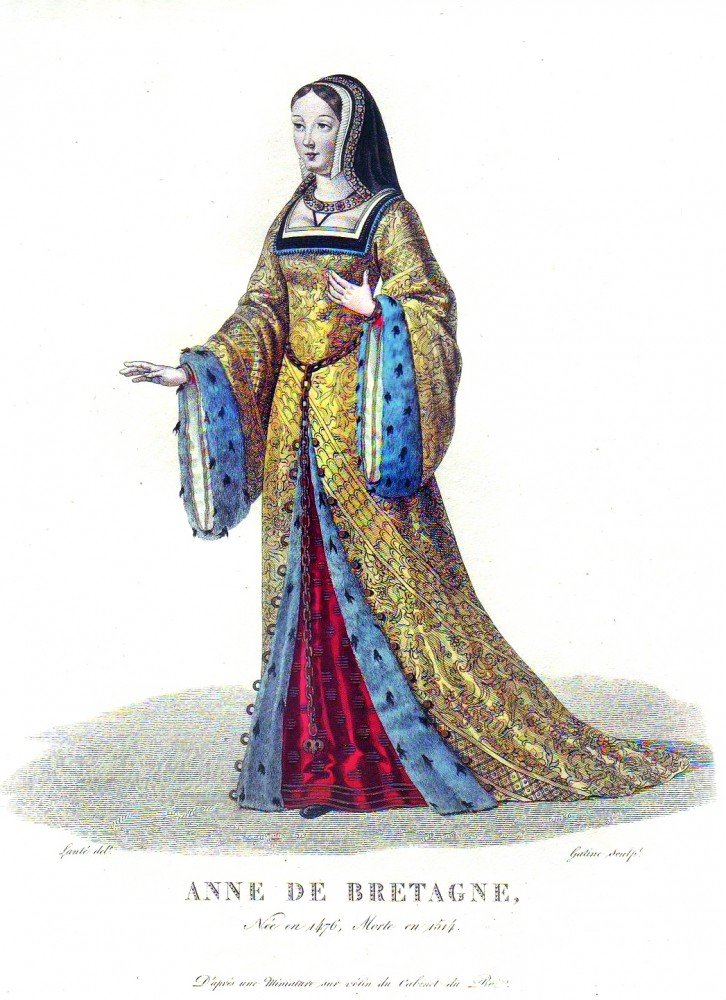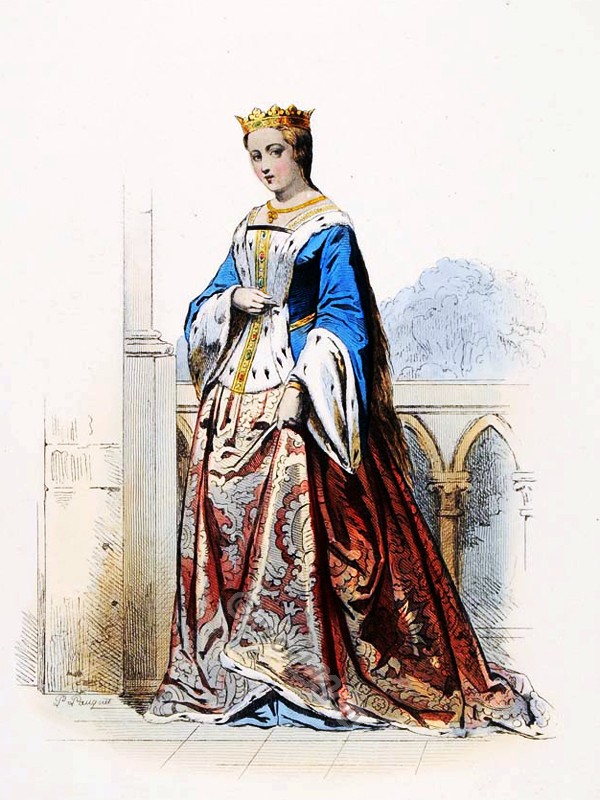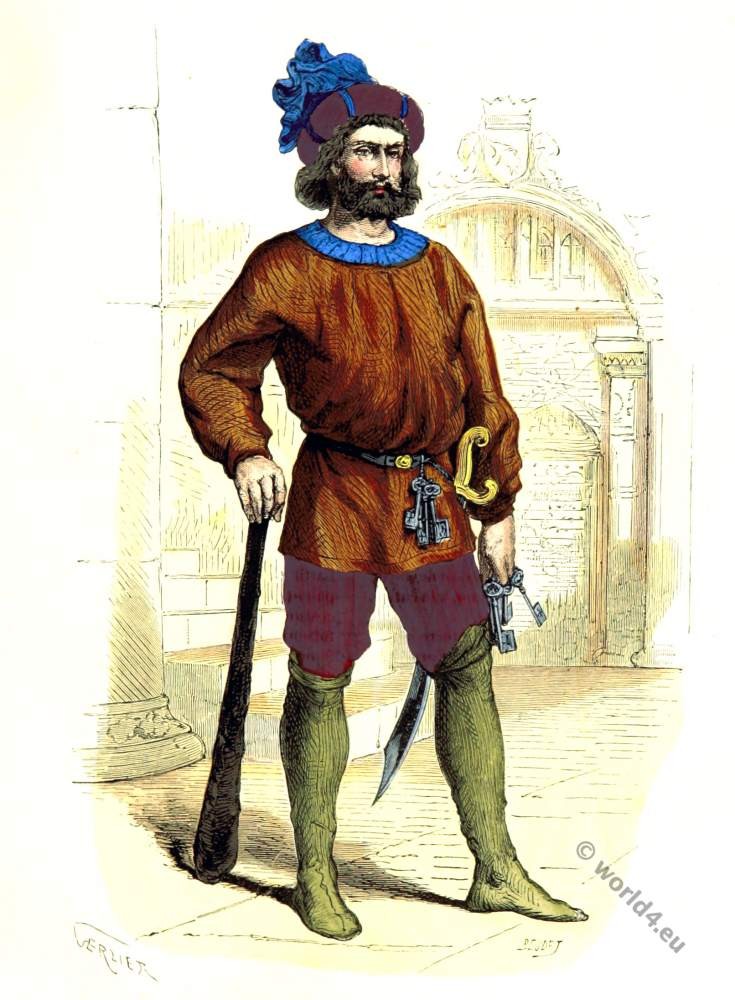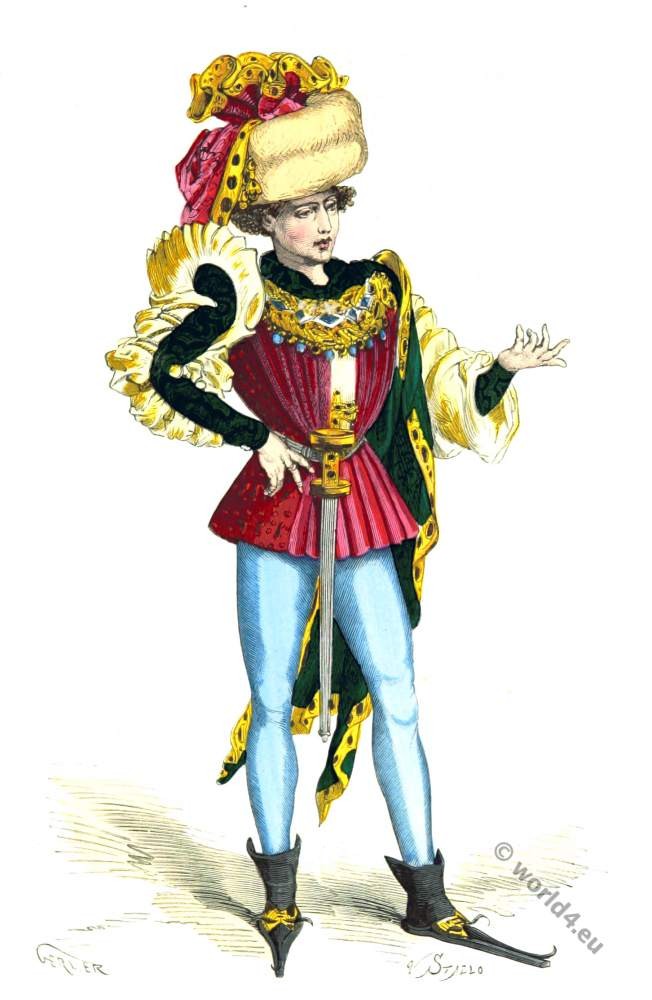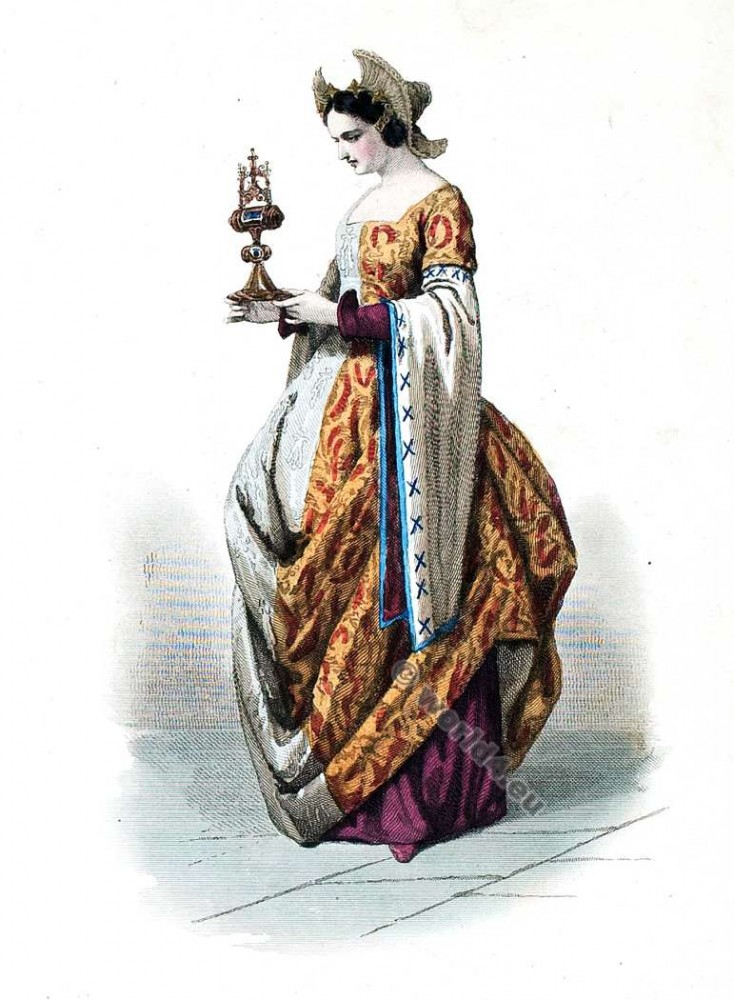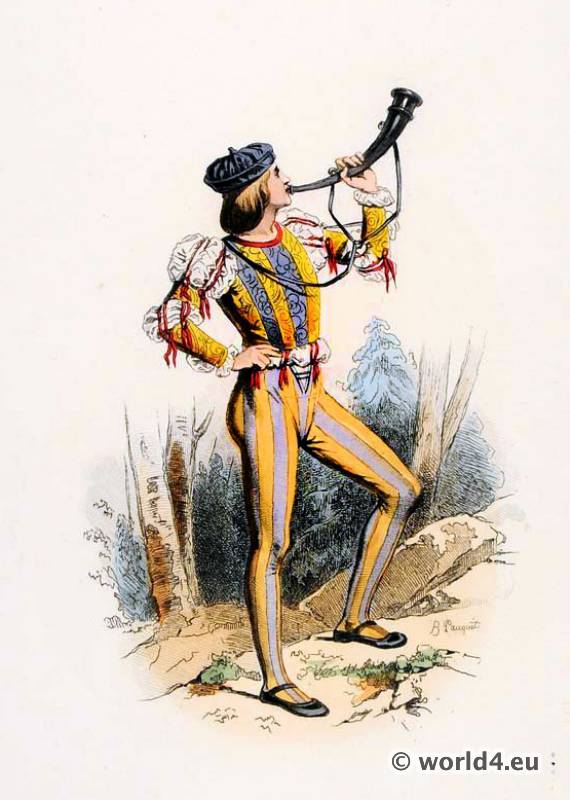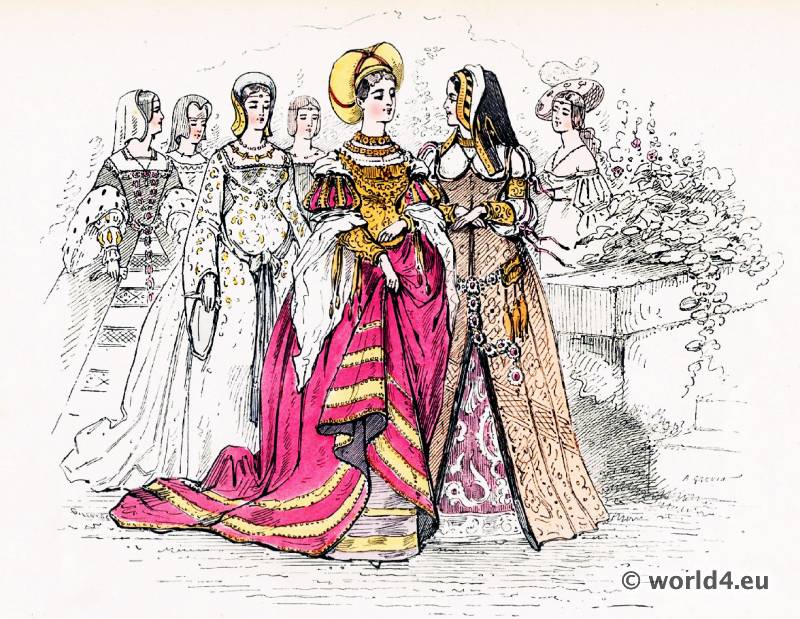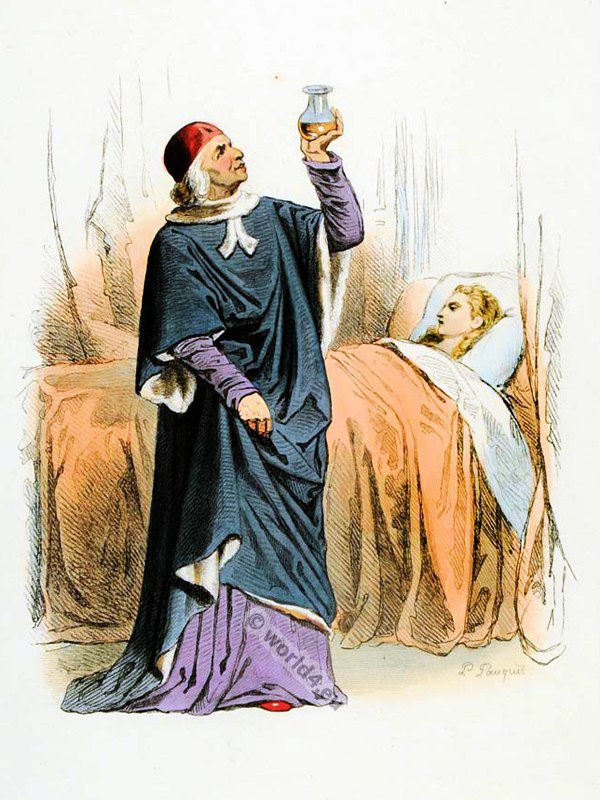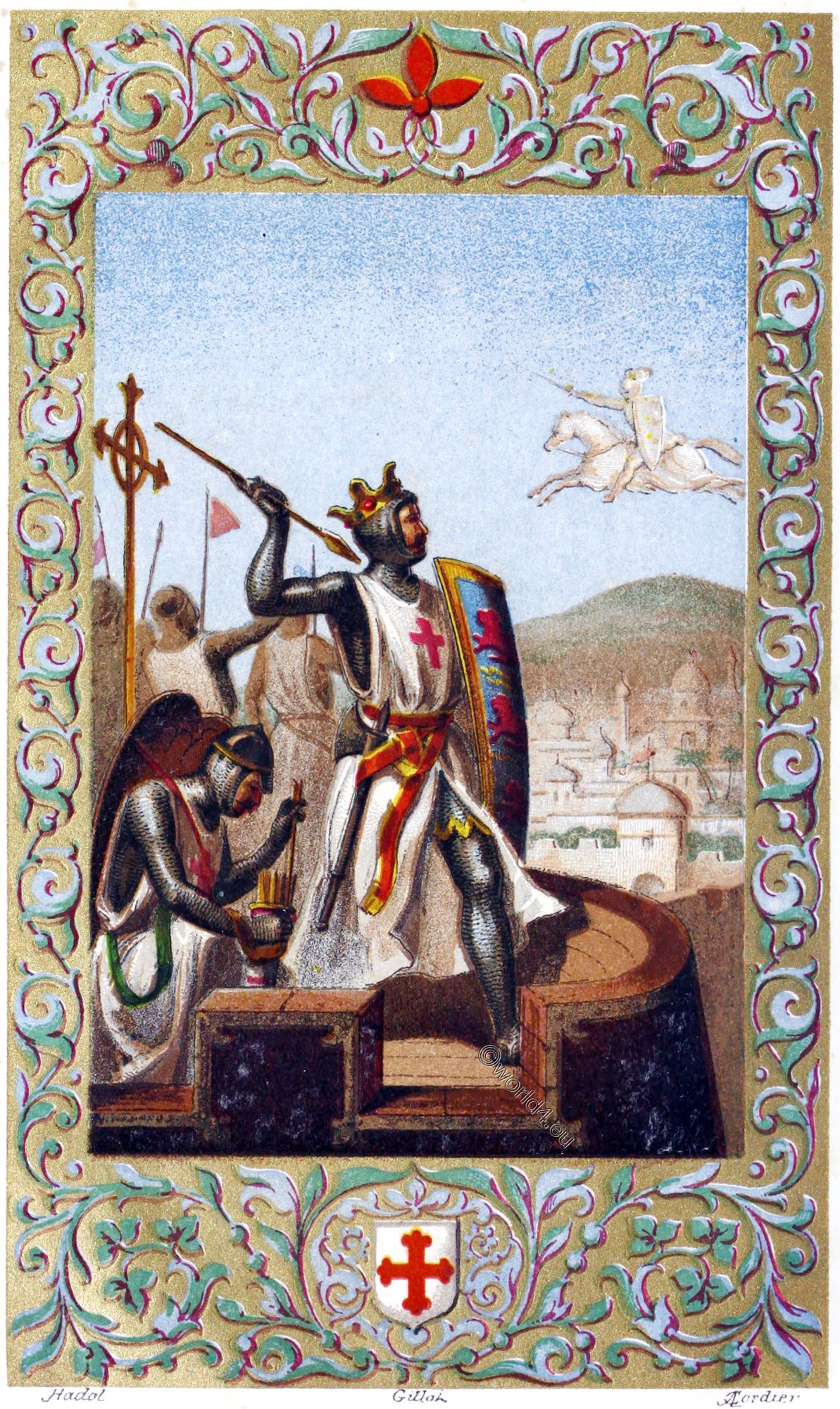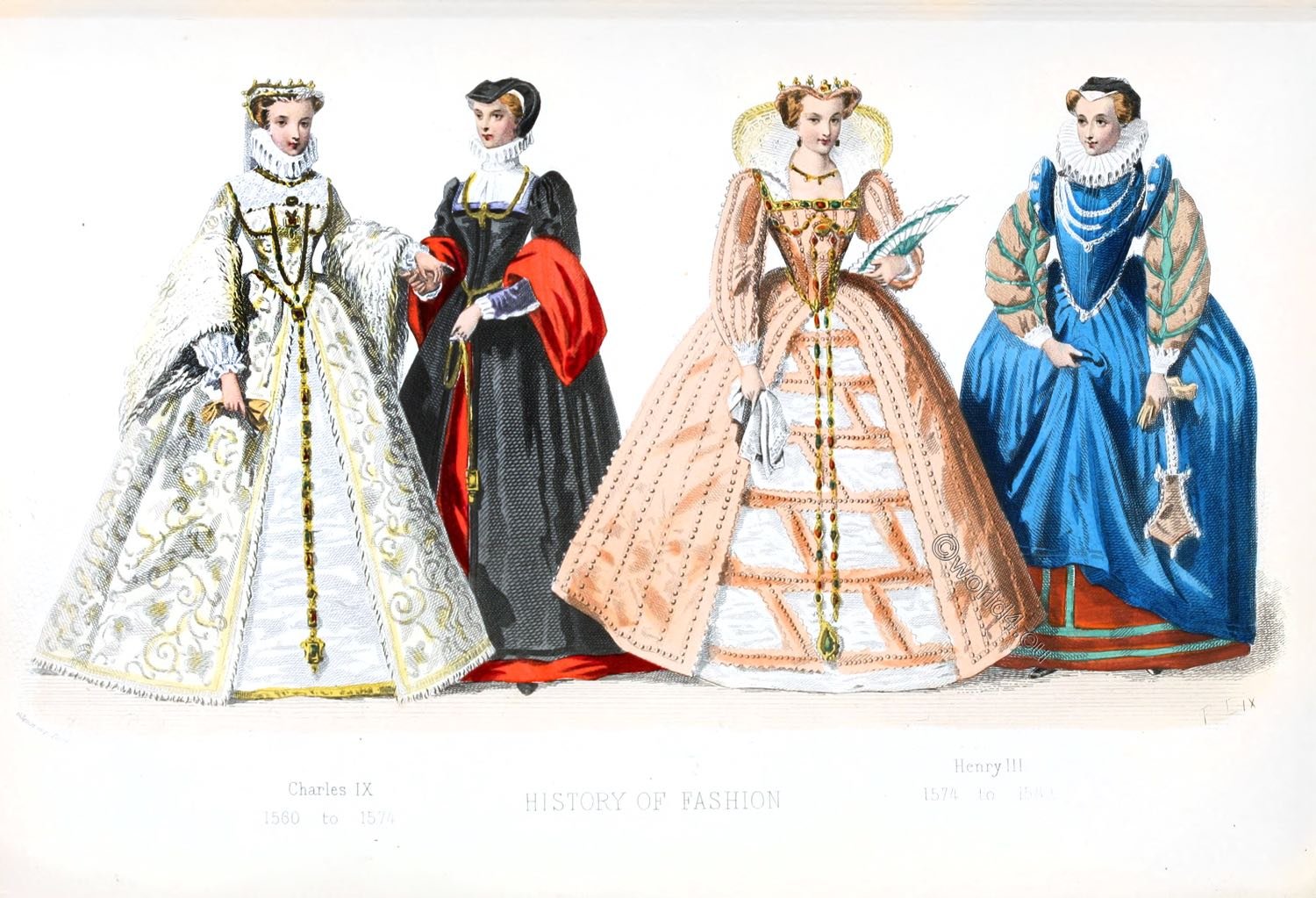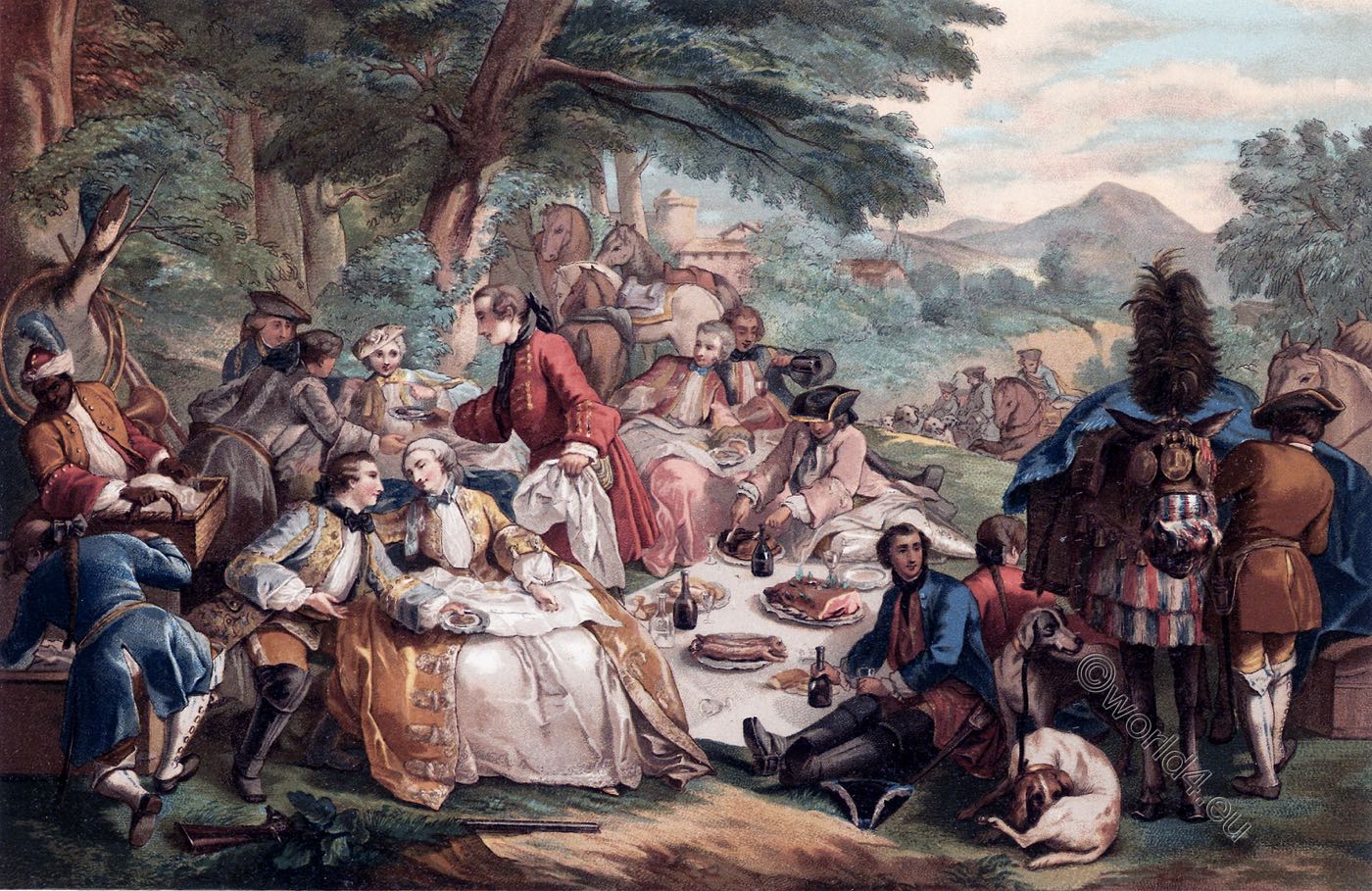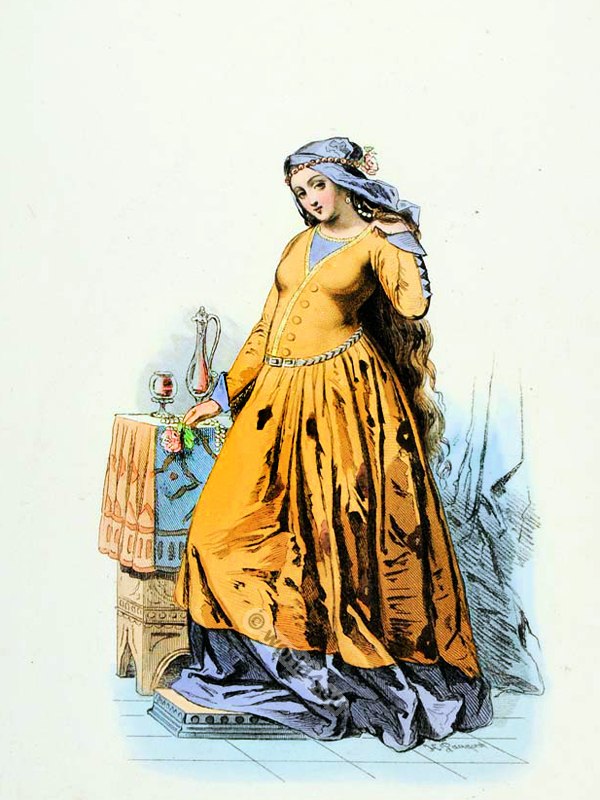
Fashion under the Reigns of Charles VIII 1483 to 1498. Louis XII 1498 to 1515.
Duchesses and bourgeoises under Louis XI. – “La grand gorre,“ or sumptuosity – The “troussoire” – Allegorical and moral costumes – Trains – Head-dresses —”Collets rebrassés ” – Wigs and false hair — Some results of the war in Italy – Italian fashions — “Sollerets” and slippers – Gorgets – Garters – Jean Marot writes against novelties – Anne of Brittany – Pins – Menot “the golden-tongued” – A Parisian in the time of Louis XII. – Coat à I’ltalienne – Manufacture of stuffs.

- Louis XI. 1423-1483, called le prudent, le ruse or l’araignée was from 1461 to 1483 King of France.
- Charles VIII, 1470-1498, called l’Affable or le Courtois; was from 1483 to 1498 King of France. He was the third and only surviving son of Louis XI. of France and his wife Charlotte of Savoy. He was the seventh king of the House of Valois and with his death ended the Valois Main Line.
- Louis XII. 1462-1515 was from 1498 to 1515 King of France. The continued epithet of Louis XII was and is “père du peuple”, “father of the people”. This goes back to a meeting of deputies of the cities of Tours in 1506, as the honorific name was given to him by the spontaneous exclamation of a citizen.
Sudden change in the whole character of costume.
The Empire of Fashion was scarcely founded, ere it began to promulgate those despotic laws which have never been relaxed to the present day.
The spread of luxury, art, and comfort, which became manifest at the dawn of the Renaissance, led to a sudden change in the whole character of costume. This fact has been commented on by all historians ; and can be verified and explained by the archives of the period.
Although for the most part Louis XI. affected a great simplicity in his dress, and was fond of playing the “bourgeois,” yet at times he desired to see his palace filled with nobles richly attired, and wearing magnificent stuffs, even of foreign manufacture.
The astute sovereign appreciated the influence of fashion on commercial prosperity.
Then commenced a competition in dress between the bourgeoisie of the towns and the nobility; as says the poet,—
“En Paris, y en a beaucoup
Qui n’ont d’argent, vergier, ne terre,
Que vous jugeriez chascun coup
Alliés aux grands chefs de guerre,
Ils se disent issus d’Angleterre,
D’un comte, d’un baron d’Anjou,
Parents aux sénéchaux d’Auxerre,
Ou auxchâtelains du Poitou,
Combien qu’ils soient saillis d’un trou,
De la cliquette d’un meunier,
Voire ou de la ligne’e d’un chou,
Enfans à quelque jardinier…
Une simple huissière,
ou clergesse Aujourd’hui se présumera
Autant et plus qu’une duchesse;
Heureux est qui en finira!
Une simple bourgeoise aura Rubis,
diamans et joyaux,
Et Dieu sait si elle parlera
Gravement en termes nouveaux !”…
(“There may be seen in Paris many who possess neither money, house, nor land, but whom you would take, at a glance, to be allied to the greatest chiefs and warriors. They say that they come from England, and are the issue of a count, or a baron of Anjou, and related to the seneschals of Auxerre, or the lords of manors in Poitou. And for the most part they come from holes and corners, out of the loft of a miller, perhaps, or of the lineage of a cabbage, children of a gardener. The wife of a mere clerk, or a doorkeeper, presumes nowadays as much as a duchess. It would be well there should be an end of this ! You shall see a simple bourgeoise decked out with diamonds and jewels, and talking gravely, in good sooth, in all the new phrases.“)
Duchesses and bourgeoises under Louis XI.
Maillard, a preacher of the day, declaimed against “gorgeous” women (“femmes a la grand’gorre”), rebuking them for their long trains, their furs, and gold ornaments. He sketched the portrait of a lawyer’s wife dressed like a princess. Other preachers drew comparisons between the poverty of the people and the self-indulgence of fine ladies. “The poor,” says one of them, “are dying of cold; while you, Madame Pompous, Madame Boastful (“la braguarde”), you have seven or eight gowns in your coffer that you do not put on thrice in the year.”

Epoque de Louis XI, 1460 
Cour de Louis XI, 1480 
Cour de Louis XI, 1480 
Epoque de Louis XII, 1510 
Cour de Louis XII, 1510 
Cour de Louis XII, 1510
The Troussoire
So long as the bourgeoises dressed above their station, it was naturally next to impossible that the female aristocracy should not endeavour to eclipse their humbler rivals. “The married ladies, and the young ladies at the court of Louis XI., no longer wore trains to their gowns, but they wore borderings of fur and of velvet, and of other materials the same width as velvet; on their heads they wore round padded caps, with peaks half a yard in height— some more, some less— and fastened above these were long veils reaching to the ground behind, with silken girdles four or five inches wide, with both the metal work and the tissue wide and gilt, and weighing six or seven silvern ounces; and on their necks broad collars of gold of diverse workmanship.”
One side of their long skirts was held up by a “troussoire” or clasp. The troussoire consisted of a chain, of more or less value, which was attached to the girdle and to which a small scentbox, some keys, and a strong clasp for holding up the gown, besides other little articles, were suspended.
Olivier de la Marche in his poem of “Le Triomphe des dames” (1464), recommended fine ladies to wear costumes of allegorical and moral significance, viz., slippers of humility, shoes of diligence, stockings of perseverance, garters of firm purpose, a cotte of chastity, a waistband of magnanimity, a pincushion of patience, a purse of liberality, a knife of justice, a ring of faith, a comb of stings, a hood of hope, &c. He spoke in jest; but Jean Juvénal des Ursins (1388-1473, was a French historian, diplomat and bishop.) was in serious earnest, when in 1467 he told the States-General, “Another wound of the State lies in coats of silk; and as to women, God knows how they are attired, in gowns of the said material, cottes, and in many and divers ways. In bygone days we have seen how damosels and other women, by merely turning up the edge of their dresses in a fashion called “profit,” looked like handsome white cats; nowadays they make these “profits” of silk material as wide as cloth, with great horns or high towers on their heads, or couvrechefs of stuff or silk reaching to the ground… .”
Collets rebrassés
Dresses were now profusely trimmed with ribbons and cords; and the mode of the silk corset separate from the skirt was adopted; the gown was of Florence satin, open up the front, and in winter lined with badger’s fur.
By these means noble ladies marked the distinction between themselves and mere bourgeoises. A thin wooden busk in the front of the corset was called a “coche.” Occasionally the chemise, artistically arranged, took the place of the corset, properly so-called, which had itself succeeded to the “bliaud.” Towards 1480, women uncovered the neck very much in full dress, and ” collets ” or collars were worn turned downwards almost to the arms. These were called “rebrasses,” and were often trimmed with fur. Villon mentions them in his ” Grand Testament:”— “Dames à rebrassez collets, De quelconque condicion ” …
(“Ladies with turned-down collars, Of whatever condition.“)
There were three kinds of head-gear, the pyramid, the truncated, terminated by a button, and the small “barillet,” which was like a little barrel. Hats were more general under Charles VI. and Charles VII., and were worn at all times. Long hair, whether natural or false, was called a wig.
Working women going into the towns to sell their merchandise or their work, wore a white apron and a gown of cloth, serge, or woollen; they were bareheaded, the hair being confined by a band on the forehead and hanging loosely behind. They imitated the bourgeoises in the make of their dresses, but refrained from trains. The fashion of hanging sleeves was succeeded by that of tight, close-fitting ones. Gowns were made with bodices laced up in front like the Swiss costume; and the collars, sleeves, and edge of the skirt were bordered with a wide band of velvet; the sleeves hung down to the ground. A girdle of velvet covered with goldwork fitted tightly to the waist. Another girdle called a “surceinte” embroidered with mottoes, initials, and even with heraldic arms, confined the outer garment.
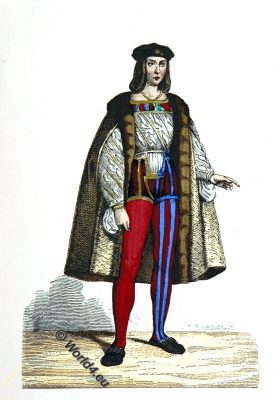
Poets raised their voices against the false hair, which was worn over the forehead till it touched the eyes; the ears were hidden by it, and the ends, reaching to the shoulders, were curled. The hair was either white, or of the bright yellow colour fashionable at the present day. An infusion of onion-skin was sometimes used as a dye.
Wigs and false hair
In the reign of Louis XI., French ladies “adorned” themselves with enormous head-dresses, three quarters of a yard in height, stuffed into various shapes, viz., a heart reversed, a shell, or a cushion, and covered with beads and precious stones.
Doorways were widened that ladies might pass through them. Montesquieu, writing on the subject, says that “architects have often been obliged to contravene the rules of their art as to the dimensions of entrances to our apartments, in order to bring them into proportion with women’s adornments.”

Headdress 15th century 
Headdress 15th century 
Anne of Bretagne, Claude de France? 
Headdress 15th century 
Dame nobles de 1495 à 1500. Hair Fashion from 1495 to 1500. 
Dame nobles de 1495 à 1500. Hair Fashion from 1495 to 1500. 
Burgundian characteristic headgear 1460 – 1500
The fashion of long hair and also of false hair lasted until the close of the reign of Louis XII. The admirable miniatures on the manuscripts of the fifteenth century certainly point to an improvement in head-dressing, as well as in attire generally. We learn from them that the sugarloaf head-dress was in fashion during the whole of that century. It was ordinarily bordered in front with gold embroidery on black velvet. That portion of the dress which covered the chest was of black velvet, embroidered in the upper part, and of gold tissue as far as the waist.
Some results of the war in Italy — Italian fashions
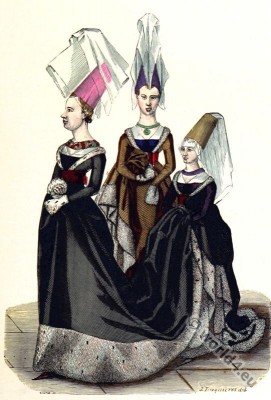
The outer dress was of blue velvet, embroidered in gold, and lined and bordered with crimson velvet. The edge of the sleeves was of the same. The veil was white and transparent, the belt green, and sparkling with gold ornaments. That part of the under-dress which was visible below was violet; the shoes were black.
Generally speaking, the train of a great lady was borne by a young girl. The head-dress of the latter was black or brown velvet. Our fair readers will remember that Charles VIII., son of Louis XI., made a warlike expedition into Italy, where the ” French fury ” was lavishly displayed. They are familiar, no doubt, with accounts of the entry of Charles VIII. into Florence, Rome, Capua, and Naples successively. “The discovery of Italy,” an historian very justly remarks, “had turned the heads of the French; they were not strong enough to withstand its charm. We use the right expression when we say ‘ discovery.’
The companions of Charles VIII. were not less astounded than were those of Christopher Columbus.” The Italians, on the other hand, greatly admired the agreeable manners of the French. As Charles VIII. made his progress through their country, they assumed the French mode of dress, and sent for all manner of finery from France. Victors and vanquished made mutual exchange of manufactured productions.
When the King of France had once more crossed the Alps and returned to his capital, the French ladies in their turn experienced the fascination that the soldiers of Charles VIII. had succumbed to in Italy. Their “heads were” likewise “turned,” and their enthusiasm naturally had its effect on the fashions of the day. Our fair countrywomen laid aside the sombre garments of the time of Louis XL, and began to wear the brightest colours, as well as several materials of Milanese or Venetian manufacture.
The French, who still wore the striking costumes of the days of chivalry, excited eager curiosity wheresoever they went, and the greater the contrast between their garments and those of the Italians, the more did the latter delight in wearing the French fashions. They willingly exchanged their Genoese trinkets and jewels against the products of the Arras looms, if only from mere love of novelty.
Many Italian fashions were added to our national costume viz., tight fitting bodices, highly ornamented; very wide sleeves; white gowns trimmed with many coloured fringes; and black veils. The ladies would no longer wear the hennin, which had been so fashionable in the reign of Charles VI., and declared it was horrible.

Sollerets and slippers
For poulaines “sollerets” were substituted; these were rounded to the shape of the feet. Very light slippers were made in velvet or satin, of the same shape as soUerets ; and shoes, something like high pattens, that were worn over the slippers. ” Nos mignonnes,” says the poet Guillaume Coquillart, in ” Les Droits Nouveaulx,”— “Nos mignonnes sont si trèshaultes, Que, pour paraitre grandes et belles, Elles portent pantoufles haultes Bien à vingt et quatre semelles.”
(“Our fair ones are so grand, ‘I’hat to appear tall and fair, They must have high slippers Even with four-and-twenty soles.“)
Gorgets, Garters
Hose, or stockings, were composed of several pieces of stuff sewed together. Chemises of woollen stuff were in general use. The “gorgerette” or gorget, a linen collar, either plain or plaited, reached as high up as the collar-bones, and was worn over the “piece” or “plastron” of stuff that was laced across the chest. The “demi-ceint” was a small silken scarf, wound about the waist and fastened in front by a rosette.
The “ceinture” was a wide ribbon, worn flat over the hips and ending in an angle on the skirt, where it formed a rosette with two floating ends. Among the accessories of dress were garters, either fastened by a buckle or simply tied. These were ornamented, in the fifteenth century, with mottoes or initials. Women also made use of pincushions, of purses in the shape of bags, of knives, of “rings” — meaning probably necklaces, and of paternosters or rosaries of gold, pearls, or other valuable materials. These were fastened to the knot of the girdle, and hung down in front of the gown.

Louis XII 
Louis XII (1462 – 1515) „père du peuple“ from the House of Valois-Orléans. 
Page, Reign of Louis XII 1500 
Parisian Bourgeois in the Reign of Louis XII 1510. 
Louis XII – 1515
Jean Marot writes against novelties
We have already mentioned these rosaries. In the reign of Louis XII., the successor of Charles VIII., the dress of women was but slightly changed. The upper gowns were made shorter, reaching only to the knees, and resembled a wide cloak or cape, cut low on the bosom. One great novelty was the shape of the sleeves, which in the upper gown remained wide and flowing, but those belonging to the under bodice consisted of several separate pieces fastened together by ribbons. We can picture to ourselves the elegant appearance of a sky-blue bodice, of a dark blue cloth gown, and of green sleeves in superfine cloth.
Some women dressed in Genoese, or Milanese, or Greek fashion. The poet Jean Marot (1450-1525, Secretary and Poet Laureate of the French queen, Anne of Brittany) is unsparing in his criticisms on such women:— “De s’accoustrer ainsi qu’une Lucrèce, A la lombarde ou la façon de Grèce, Il m’est avis qu’il ne se peut faire Honnestement.” Garde-toi bien d’estre I’inventeresse D’habitz nouveau; car mainte pécheresse Tantot sur toy prendrait son exemplaire. Si a Dieu veux et au monde complaire, Pone l’habit qui denote simplesse Honnestement.” (“To accoutre oneself like a Lucretia, A Lombard woman, or in Grecian fashion, It is my belief cannot be done With honesty. ” Beware of being the inventress Of new attire, for many a sinner Might make thee her exemplar. If thou would please God and the world, Wear the dress that denotes simplicity In honesty.”)
Anne of Brittany
A considerable number of wealthy ladies began to frequent the court, attracted thither by the fascinating manners of Anne of Brittany, ” the good queen,” whose whims became a law, according to which all Frenchwomen regulated their dress, whatever might be their position in the social scale.

Anne de Bretagne 1477-1514, 2ème Femme de Louis XII, d´après Gaignières, 1500. Modes et Costumes Historiques 1864. 
Anne de Bretagne (1477-1514), Duchess of Brittany, Queen of France. 
Princess according to the times of Anne De Bretagne, 1420
It is worthy of remark that, at the close of the Middle Ages and during the first years of the Renaissance, brides wore red or scarlet on their wedding-day. Anne of Brittany was celebrated for the beauty of her leg and foot, and liked to wear her skirts short. Most women followed her example in that respect.
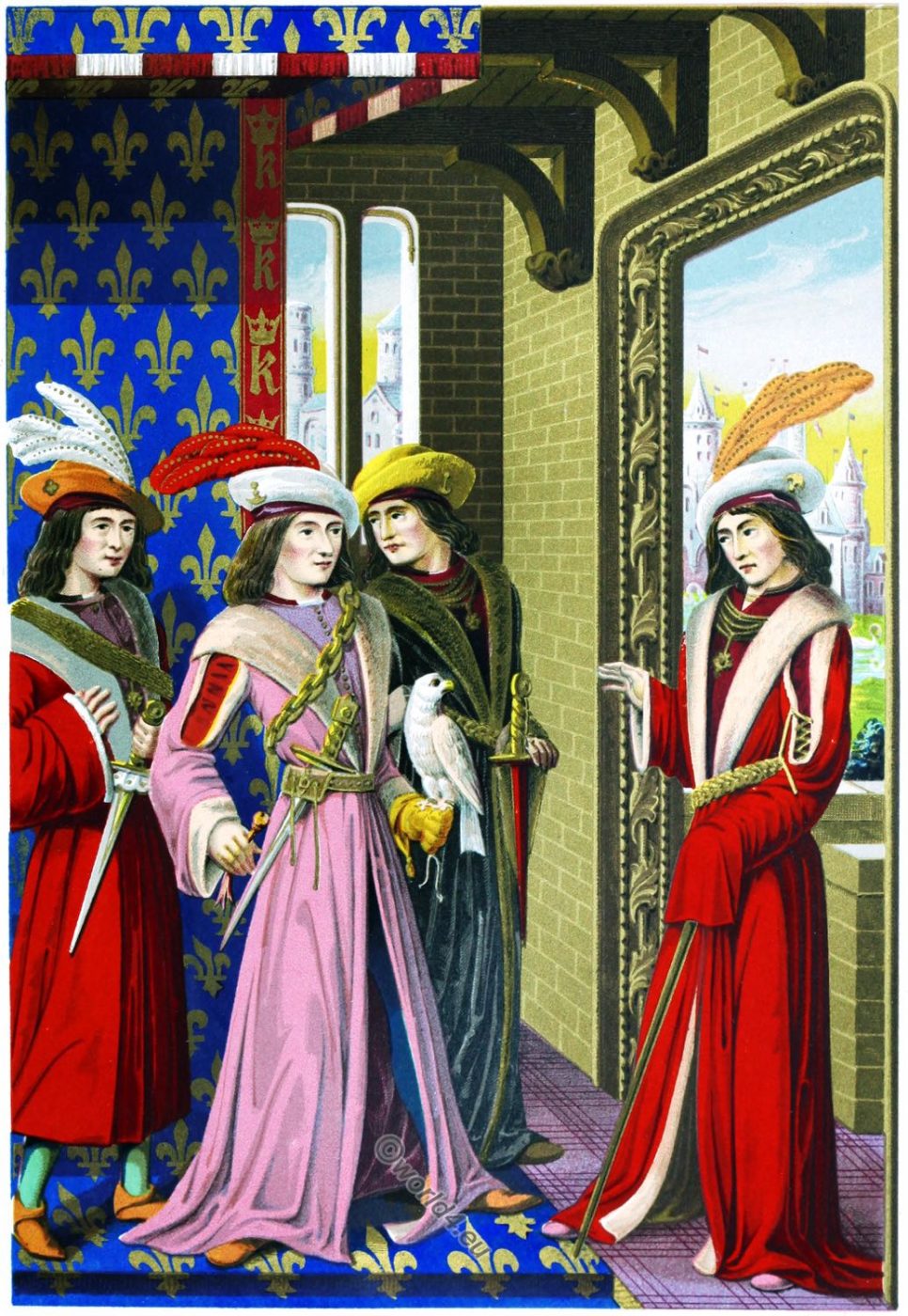
Menot the Golden Tongue
For a long time past ladies had made use of pins, gilt pins even; they now began to outstrip the bounds of moderation in their use. “Oh, ladies!” exclaimed Michel Menot, the Franciscan monk, surnamed the Golden Tongue, “Oh, ladies! who are so dainty, who so often miss hearing the Word of God, though you have only to step across the gutter to enter the church, I am certain it would take less time to clean out a stable for forty-four horses than to wait until all your pins are fastened in their places. … When you are at your toilet you are like a cobbler, whose business is to ‘ stop up,’ and to ‘ rub,’ and to ‘ put to rights,’ and who needs a thousand different articles for bits and patches.” He added: “A shoemaker’s wife wears a tunic like a duchess.” Vainly did the preacher thunder against pins.
Fashion could not be in the wrong. Presumptuous were they who attacked her, for her partisans increased with the number of her opponents. We must now point out a change in the mode of wearing mourning. The former queens of France had worn white for mourning.

French Jailor in 1490. Geolier en 1490. Paris à travers les siècles. 
Young stylish fashion in 1480. France 15th century. 
Dame française du temps de Charles VIII 
Cour de Charles VII, 1460 
Page in the Reign of Louis XII., 1500.
On the death of Charles VIII., Anne of Brittany for the first time wore black. She wore a white silk cord round her waist, and had a similar cord affixed to her coat-of-arms, knotted in four places and twisted into four loops, forming the figure of 8, so as publicly to display her grief for the loss of so beloved a husband.
Clément Marot, the son of Jean Marot, has given us the following sketch of a fashionable Parisian lady in the time of Louis XII.:— “O mon Dieu ! qu’elle estoit contente De sa personne ce jour-là ; Avecques la grace qu’elle a, Ella vous avoit un corset D”un fin bleu, lace d’un lacet Jaune, qu’elle avoit faict exprès. Elle vous avoit puis après Mancherons d’escarlate verte, Robe de pers, large et ouverte. Chausses noires, petits patins, Linge blanc, ceinture houppée, Le chaperon faict en poupée…”
A cord twisted so as to form a figure of 00 was called a lac d’amour, or love-knot.— Translator’s note. “Heavens! how satisfied she was With her good looks that day ! With all her dainty graces ! Look you, she had a bodice Of the finest sky-blue, laced With a lace of yellow, made for her. And then she had sleeves of green Of rich stuff, and a gown Both wide and open. Black hosen, little slippers, White linen, a looped girdle, And a fair kerchief on her head-dress.”
Sometimes, as we see by a manuscript in the National Library, French ladies would dress after the Italian fashion, that is, with a greater quantity of jewels, and without head-gear; their hair being curled at the side, and plaits wound round the head. Although extravagance in dress had not yet reached the point which it afterwards attained under the chivalrous Francis I., yet it began to be universally displayed in both masculine and feminine attire.
Manufacture of stuffs.
At the privileged fairs, quantities of materials of more or less value were offered for sale. Bourges was so famous for its cloth, that wealthy purchasers frequently stipulated that their coats should be made in “fine Bourges cloth.”
Foreign manufactures of gold, silver, and silk entered France by way of Susa, when coming from Italy; Spanish goods were sent by way of Narbonne and Bayonne, whence they were forwarded direct to Lyons, where they were unpacked and sold. The Parisienne was longer by one half than that of Flanders, Holland, England, and other countries. Ordinary wool for women’s garments was sufficiently plentiful in France. The finer cloths were generally manufactured from English and Spanish wools. Lower Brittany and Picardy supplied, it is true, a somewhat finer quality, which was used in the manufacture of certain cloths, and in particular for one called camelot. Linen-cloth was produced in considerable quantities, but was inferior in quality to the Dutch linen, which was much esteemed, and formed an important item in the trousseaux of young girls.
Source:
- Les arts somptuaires: historie du costume et de l’ameublement et des arts et industries qui s’y rattachent von Charles Louandre, Ferdinand Seré, Clus Ciappori. Paris Hangard-Maugé 1857.
- The history of fashion in France, or, The dress of women from the Gallo-Roman period to the present time by Augustin Challamel, Frances Cashel Hoey, John Lillie. Publisher: New York, Scribner and Welford, 1882.
Related
Discover more from World4 Costume Culture History
Subscribe to get the latest posts sent to your email.

